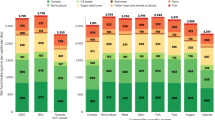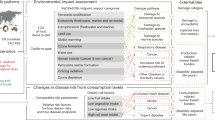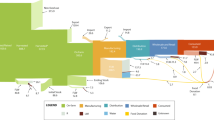Abstract
Reducing food loss and waste (FLW) could lessen the environmental impacts of food systems and improve food security. However, rebound effects—whereby efficiency improvements cause price decreases and consumption increases—may offset some avoided FLW. Here we model rebounds in food consumption under a scenario of costless FLW reduction. We project that consumption rebound could offset 53–71% of avoided FLW. Such rebounds would imply similar percentage reductions in environmental benefits (carbon emissions, land use, water use) and improvements in food security benefits (increased calorie availability), highlighting a tension between these two objectives. Evidence from energy systems suggests that indirect effects not included in our analysis could further increase rebounds. However, costs of reducing FLW would reduce rebounds. Rebound effects are therefore important to consider in efforts aimed at reducing FLW.
This is a preview of subscription content, access via your institution
Access options
Access Nature and 54 other Nature Portfolio journals
Get Nature+, our best-value online-access subscription
$29.99 / 30 days
cancel any time
Subscribe to this journal
Receive 12 digital issues and online access to articles
$119.00 per year
only $9.92 per issue
Buy this article
- Purchase on Springer Link
- Instant access to full article PDF
Prices may be subject to local taxes which are calculated during checkout






Similar content being viewed by others
Data availability
We used public data from FAOSTAT (https://www.fao.org/faostat/en/), the United Nations Environment Program Food Waste Index Report database (https://www.unep.org/resources/report/unep-food-waste-index-report-2021) and the 2019 State of Food and Agriculture Report (https://www.fao.org/documents/card/en?details=ca6030en). We also used data from relevant literature as cited in our study54,55. All data used in this study are included as supplementary information and are also publicly available at https://github.com/mhegwood/foodwaste. Source data are provided with this paper.
Code availability
Data analysis was conducted in MATLAB (version 9.11.0.1809720 (R2021b) Update 1) and Mathematica (version 11.3). The code used in this study is included as supplementary information and is also publicly available at https://github.com/mhegwood/foodwaste.
References
State of Food and Agriculture 2019. Moving Forward on Food Loss and Waste Reduction (FAO, 2019).
Food Waste Index Report 2021 (UNEP, 2021).
van den Bos Verma, M., de Vreede, L., Achterbosch, T. & Rutten, M. M. Consumers discard a lot more food than widely believed: estimates of global food waste using an energy gap approach and affluence elasticity of food waste. PLoS ONE 15, e0228369 (2020).
Poore, J. & Nemecek, T. Reducing food’s environmental impacts through producers and consumers. Science 360, 987–992 (2018).
Bellemare, M. F., Çakir, M., Peterson, H. H., Novak, L. & Rudi, J. On the measurement of food waste. Am. J. Agric. Econ. 99, 1148–1158 (2017).
Xue, L. et al. Missing food, missing data? A critical review of global food losses and food waste data. Environ. Sci. Technol. 51, 6618–6633 (2017).
Godfray, H. C. J. et al. Food security: the challenge of feeding 9 billion people. Science 327, 812–818 (2010).
Bajželj, B. et al. Importance of food-demand management for climate mitigation. Nat. Clim. Change 4, 924–929 (2014).
Schuster, M. & Torero, M. Global Food Policy Report (International Food Policy Research Institute, 2016).
West, P. C. et al. Leverage points for improving global food security and the environment. Science 345, 325–328 (2014).
Foley, J. A. et al. Solutions for a cultivated planet. Nature 478, 337–342 (2011).
The 17 Goals (UN, 2015); https://sdgs.un.org/goals
National Food Waste Strategy (DCCEEW, 2017); https://www.environment.gov.au/protection/waste-resource-recovery/publications/national-food-waste-strategy
United States 2030 Food Loss and Waste Reduction Goal (EPA, 2019); https://www.epa.gov/sustainable-management-food/united-states-2030-food-loss-and-waste-reduction-goal
Gove Steps-Up Government Fight Against Food Waste (Defra Media, 2019); https://deframedia.blog.gov.uk/2019/05/14/gove-steps-up-government-fight-against-food-waste/
WWF Expands Food Waste Education Program to Nine Major US Cities (WWF, 2019); https://www.worldwildlife.org/press-releases/wwf-expands-food-waste-education-program-to-nine-major-us-cities
Who We Are (ReFed, n.d.); https://refed.org/about/who-we-are/
Global Initiative on Food Loss and Waste Reduction (FAO, 2017); https://www.fao.org/save-food/en/
Our Work (Food Waste Reduction Alliance, n.d.); https://www.foodwastealliance.org/about/
Gunders, D. Hospital wastes a third less food after this one change. Forbes (2019, Feb 18).
Peters, A. Everything you need to know about the booming business of fighting food waste. Fast Company (2019, June 19).
Lipinski, B. SDG Target 12.3 on Food Loss and Waste: 2021 Progress Report (Champions123, 2021). Available at: https://champions123.org/publication/sdg-target-123-food-loss-and-waste-2021-progress-report
Sorrell, S., Dimitropoulos, J. & Sommerville, M. Empirical estimates of the direct rebound effect: a review. Energy Policy 37, 1356–1371 (2009).
Sorrell, S. The Rebound Effect: an Assessment of the Evidence for Economy-Wide Energy Savings from Improved Energy Efficiency (United Kingdom Energy Research Centre, 2007).
Allan, G., Gilmartin, M. & Turner, K. UKERC Review of Evidence for the Rebound Effect: Computable General Equilibrium Models (UKERC, 2007).
Schipper, L. & Grubb, M. On the rebound? Feedback between energy intensities and energy uses in IEA countries. Energy Policy 28, 367–388 (2000).
Saunders, H. D. The Khazzoom–Brookes postulate and neoclassical growth. Energy J. 13, 131–148 (1992).
Li, H. & Zhao, J. Rebound effects of new irrigation technologies: the role of water rights. Am. J. Agric. Econ. 100, 786–808 (2018).
Dumont, A., Mayor, B. & López-Gunn, E. Is the rebound effect or Jevons paradox a useful concept for better management of water resources? Insights from the irrigation modernisation process in Spain. Aquat. Procedia 1, 64–76 (2013).
Berbel, J. & Mateos, L. Does investment in irrigation technology necessarily generate rebound effects? A simulation analysis based on an agro-economic model. Agric. Syst. 128, 25–34 (2014).
Cirera, X. & Masset, E. Income distribution trends and future food demand. Phil. Trans. R. Soc. Lond. B 365, 2821–2834 (2010).
Rutten, M. M. What economic theory tells us about the impacts of reducing food losses and/or waste: implications for research, policy and practice. Agric. Food Secur. 2, 13 (2013).
Hagedorn, W. & Wilts, H. Who should waste less? Food waste prevention and rebound effects in the context of the Sustainable Development Goals. GAIA Ecol. Perspect. Sci. Soc. 28, 119–125 (2019).
Albizzati, P. F., Rocchi, P., Cai, M., Tonini, D. & Astrup, T. F. Rebound effects of food waste prevention: environmental impacts. Waste Manag. 153, 138–146 (2022).
Chitnis, M., Sorrell, S., Druckman, A., Firth, S. K. & Jackson, T. Who rebounds most? Estimating direct and indirect rebound effects for different UK socioeconomic groups. Ecol. Econ. 106, 12–32 (2014).
Meshulam, T., Font-Vivanco, D., Blass, V. & Makov, T. Sharing economy rebound: the case of peer-to-peer sharing of food waste. J. Ind. Ecol. https://doi.org/10.1111/JIEC.13319 (2022).
Qi, D. & Roe, B. E. Foodservice composting crowds out consumer food waste reduction behavior in a dining experiment. Am. J. Agric. Econ. 99, 1159–1171 (2017).
Sundin, N., Persson Osowski, C., Strid, I. & Eriksson, M. Surplus food donation: effectiveness, carbon footprint, and rebound effect. Resour. Conserv. Recycl. 181, 106271 (2022).
Berkhout, P. H. G., Muskens, J. C. & Velthuijsen, W. J. Defining the rebound effect. Energy Policy 28, 425–432 (2000).
Azevedo, I. M. L. Consumer end-use energy efficiency and rebound effects. Annu. Rev. Environ. Resour. 39, 393–418 (2014).
Gillingham, K., Kotchen, M. J., Rapson, D. S. & Wagner, G. The rebound effect is overplayed. Nature 493, 475–476 (2013).
Saunders, H. D. Historical evidence for energy efficiency rebound in 30 US sectors and a toolkit for rebound analysts. Technol. Forecast. Soc. Change 80, 1317–1330 (2013).
Barker, T., Ekins, P. & Foxon, T. The macro-economic rebound effect and the UK economy. Energy Policy 35, 4935–4946 (2007).
Barker, T., Dagoumas, A. & Rubin, J. The macroeconomic rebound effect and the world economy. Energy Effic. 2, 411–427 (2009).
Stern, D. I. How large is the economy-wide rebound effect? Energy Policy 147, 70 (2020).
Druckman, A., Chitnis, M., Sorrell, S. & Jackson, T. Missing carbon reductions?: exploring rebound and backfire effects in UK households. Energy Policy 39, 3572–3581 (2011).
Pearson, P., Fouquet, R., Pearson, P. & Fouquet, R. Energy efficiency, economic efficiency and future CO2 emissions from the developing world. Energy J. 17, 135–160 (1996).
Yu, X. et al. Regional energy rebound effect: the impact of economy-wide and sector level energy efficiency improvement in Georgia, USA. Energy Policy 87, 250–259 (2015).
Turner, K. ‘Rebound’ effects from increased energy efficiency: a time to pause and reflect. Energy J. 34, 25–42 (2013).
Lowe, R. A theoretical analysis of price elasticity of energy demand in multi-stage energy conversion systems. Energy Policy 31, 1699–1704 (2003).
Saunders, H. D. Fuel conserving (and using) production functions. Energy Econ. 30, 2184–2235 (2008).
Gillingham, K., Rapson, D. & Wagner, G. The rebound effect and energy efficiency policy. Rev. Environ. Econ. Policy 10, 68–88 (2016).
Fouquet, R. & Pearson, P. The long run demand for lighting: elasticities and rebound effects in different phases of economic development. Econ. Energy Environ. Policy 1, 83–100 (2012).
Stout, J. V. Direct Comparison of General Equilibrium and Partial Equilibrium Models in Agriculture (United States Department of Agriculture (USDA) Economic Research Service (ERS), 1991).
Green, R. et al. The effect of rising food prices on food consumption: systematic review with meta-regression. BMJ 346, f3703 (2013).
Rajagopal, D. & Plevin, R. J. Implications of market-mediated emissions and uncertainty for biofuel policies. Energy Policy 56, 75–82 (2013).
Erickson, P. & Lazarus, M. Impact of the Keystone XL pipeline on global oil markets and greenhouse gas emissions. Nat. Clim. Change 4, 778–781 (2014).
Thomas, B. A. & Azevedo, I. L. Estimating direct and indirect rebound effects for U.S. households with input–output analysis Part 1: Theoretical framework. Ecol. Econ. 86, 199–210 (2013).
Perloff, J. M. Microeconomics (Pearson Higher Education, 2007).
Food Wastage Footprint: Impacts on Natural Resources (Food and Agriculture Organization, 2013).
Food Wastage Footprint: Fool Cost-Accounting (Food and Agriculture Organization, 2014).
Gustavsson, J., Cederberg, C., Sonesson, U. & Emanuelsson, A. The methodology of the FAO study: global food losses and food waste—extent, causes and prevention (FAO, 2013).
Salemdeeb, R., Font Vivanco, D., Al-Tabbaa, A. & zu Ermgassen, E. K. H. J. A holistic approach to the environmental evaluation of food waste prevention. Waste Manag. 59, 442–450 (2017).
Latka, C. et al. Competing for food waste—policies’ market feedbacks imply sustainability tradeoffs. Resour. Conserv. Recycl. 186, 106545 (2022).
Crippa, M. et al. Food systems are responsible for a third of global anthropogenic GHG emissions. Nat. Food 2, 198–209 (2021).
Baquedano, F., Abrehe Zereyesus, Y., Valdes, C. & Ajewole, K. International Food Security Assessment, 2021–31 (USDA Economic Research Service, 2021).
Chakravarty, D., Dasgupta, S. & Roy, J. Rebound effect: how much to worry? Curr. Opin. Environ. Sustain. 5, 216–228 (2013).
Rogelj, J. et al. in: Special Report on Global Warming of 1.5 °C (eds Masson-Delmotte, V. et al.) (IPCC, WMO, 2018).
Swinburn, B. A. et al. The global obesity pandemic: shaped by global drivers and local environments. Lancet 378, 804–814 (2011).
Turner, K. Negative rebound and disinvestment effects in response to an improvement in energy efficiency in the UK economy. Energy Econ. 31, 648–666 (2009).
Khazzoom, J. D. Economic implications of mandated efficiency in standards for household appliances. Energy J. 1, 21–40 (1980).
Lipinski, B. Reducing Food Loss and Waste (2013).
Henly, J., Ruderman, H. & Levine, M. D. Energy saving resulting from the adoption of more efficient appliances: a follow-up. Energy J. 9, 163–170 (1988).
Reiss, P. C. & White, M. W. Household electricity demand, revisited. Rev. Econ. Stud. 72, 853–883 (2005).
Chalak, A., Abou-Daher, C., Chaaban, J. & Abiad, M. G. The global economic and regulatory determinants of household food waste generation: a cross-country analysis. Waste Manag. 48, 418–422 (2016).
Springmann, M. et al. Mitigation potential and global health impacts from emissions pricing of food commodities. Nat. Clim. Change 7, 69–74 (2017).
Clark, M. & Tilman, D. Comparative analysis of environmental impacts of agricultural production systems, agricultural input efficiency, and food choice. Environ. Res. Lett. 12, 064016 (2017).
FAOSTAT (FAO, 2021).
Acknowledgements
We thank P. Newton, S. Dueñas-Ocampo, R. Benzeev, L. Frankel-Goldwater, W. Eichhorst, R. Langendorf and H. Brumberg for their feedback on earlier drafts of this paper and R. Langendorf for helpful feedback and discussion on the economic analysis. M.H. and M.G.B. acknowledge funding from the US Department of Agriculture National Institute of Food and Agriculture (award number 2020-38420-30727) and the University of Colorado Boulder Cooperative Institute for Research in Environmental Sciences (start-up grant to M.G.B.). S.J.D. was supported by the US National Science Foundation and US Department of Agriculture (INFEWS grant EAR 1639318) and by the ClimateWorks Foundation (grant 22-2100).
Author information
Authors and Affiliations
Contributions
S.J.D. conceived the study. M.H., M.G.B., E.M.C. and S.J.D. performed the analyses, with support and advice from H.S., P.S. and B.B. on analytical approaches. M.H., M.G.B. and S.J.D. led the writing with input from all co-authors. All co-authors reviewed and commented on the paper.
Corresponding authors
Ethics declarations
Competing interests
The authors declare no competing interests.
Peer review
Peer review information
Nature Food thanks Marc Bellemare, Dan Blaustein-Rejto and Robert Heilmayr for their contribution to the peer review of this work.
Additional information
Publisher’s note Springer Nature remains neutral with regard to jurisdictional claims in published maps and institutional affiliations.
Supplementary information
Supplementary Information
Supplementary Note 1 and Tables 1–11.
Supplementary Data 1
Data compilation.
Supplementary Data 2
Food security calculations.
Supplementary Data 3
MATLAB input data pulled from Supplementary Data 1.
Supplementary Data 4
Model-generated results from Supplementary Software 1.
Supplementary Data 5
Input data for Fig. 4b.
Supplementary Software 1
MATLAB model code and Mathematica code for Fig. 4b.
Source data
Source Data Fig. 3
Raw data for Fig. 3.
Source Data Fig. 4
Raw data for Fig. 4a.
Source Data Fig. 5
Raw data for Fig. 5a,b.
Rights and permissions
Springer Nature or its licensor (e.g. a society or other partner) holds exclusive rights to this article under a publishing agreement with the author(s) or other rightsholder(s); author self-archiving of the accepted manuscript version of this article is solely governed by the terms of such publishing agreement and applicable law.
About this article
Cite this article
Hegwood, M., Burgess, M.G., Costigliolo, E.M. et al. Rebound effects could offset more than half of avoided food loss and waste. Nat Food 4, 585–595 (2023). https://doi.org/10.1038/s43016-023-00792-z
Received:
Accepted:
Published:
Issue Date:
DOI: https://doi.org/10.1038/s43016-023-00792-z
This article is cited by
-
Carbon farming, overestimated negative emissions and the limits to emissions trading in land-use governance: the EU carbon removal certification proposal
Environmental Sciences Europe (2024)
-
Food loss and waste reduction may backfire
Nature Food (2023)



